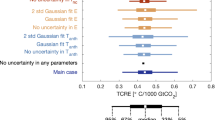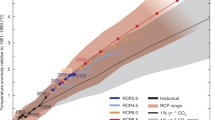Abstract
The choice of stabilization target for CO2 concentration depends on the following: what is considered to be ‘dangerous anthropogenic interference with the climate system’; the forcings that might arise from non-CO2 gases; and the climate sensitivity. These three factors are specified here probabilistically, as probability density functions (pdfs), and combined to produce a pdf for the CO2 concentration target. There is a probability of 17% that the stabilization target should be less than the present level, and the median target is 536 ppm. The effects of reducing the emissions of non-CO2 gases and/or implementing adaptation strategies are considered probabilistically and shown to alter these figures significantly.
Similar content being viewed by others
References
Andronova, N. G. and Schlesinger, M. E.: 2001, ‘Objective estimation of the probability density function for climate sensitivity’, J. Geophys. Res. 106, 22605–22611.
Forest, C. E., Stone, P. H., Sokolov, A. P., Allen, M. R., and Webster, M. D.: 2001, ‘Quantifying uncertainties in climate system properties with the use of recent climate observations’, Science 295, 113–117.
Gregory, J. M., Stouffer, R. J., Raper, S. C. B., Stott, P. A., and Rayner, N. A.: 2002, ‘An observationally-based estimate of the climate sensitivity’, J. Climate 15, 3117–3121.
Hitz, S. and Smith, J. B.: 2004, ‘Background paper: Estimating global impacts from climate change, in Benefits of Climate Policies: Improving Information for Policymakers, OECD, Paris(in press).
Manne, A. S. and Richels, R. G.: 2001, ‘An alternative approach to establishing trade-offs among greenhouse gases’, Nature 410, 675–677.
Mastrandrea, M. D. and Schneider, S. H.: 2004, ‘Probabilistic integrated assessment of ‘dangerous’ climate change’, Science 304, 571–575.
Nakićenović, N. and Swart, R., (eds.): 2000, Special Report on Emissions Scenarios, Cambridge University Press, Cambridge, UK, 570 pp.
O’Neill, B. C. and Oppenheimer, M.: 2002, ‘Dangerous climate impacts and the Kyoto Protocol’, Science 296, 1971–1972.
Smith, J. B., Schellnhuber, H.-J., and Mirza, M. M. Q.: 2001a, ‘Vulnerability to climate change and reasons for concern: A synthesis’, in McCarthy, J., Canziani, O., Dokken, D. and White, K. (eds.), Climate Change 2001: Impacts, Adaptation, and Vulnerability, Contribution of Working Group II to the Third Assessment Report of the Intergovernmental Panel on Climate Change, Cambridge University Press, Cambridge, U.K., pp. 913–967.
Sundquist, E. T., Plummer, L. N., and Wigley, T. M. L., 1979: ‘Carbon dioxide in the ocean surface: The homogeneous buffer factor’, Science 204, 1203–1205.
Wigley, T. M. L., and Raper, S. C. B.: 2001, ‘Interpretation of high projections for global-mean warming’, Science 293, 451–454.
Wigley, T. M. L., Smith, S. J., and Prather, M. J.: 2002, ‘Radiative forcing due to reactive gas emissions’, J. Climate 15, 2690–2696.
Author information
Authors and Affiliations
Corresponding author
Rights and permissions
About this article
Cite this article
Wigley, T.M.L. Choosing a Stabilization Target for CO2. Climatic Change 67, 1–11 (2004). https://doi.org/10.1007/s10584-004-3086-1
Received:
Revised:
Issue Date:
DOI: https://doi.org/10.1007/s10584-004-3086-1




